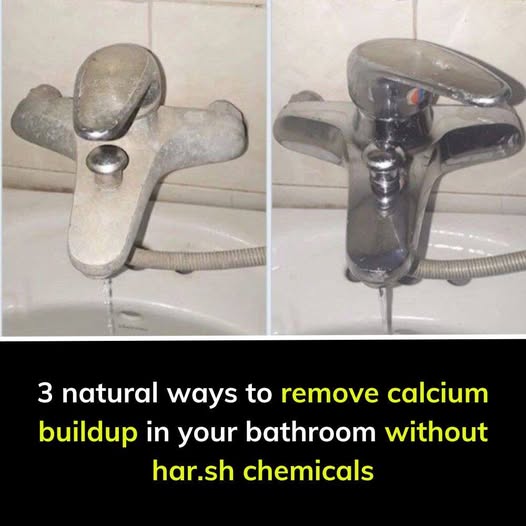ADVERTISEMENT
3 Natural Ways to Remove Calcium Buildup in Your Bathroom
Calcium buildup, also known as hard water stains, is a common problem in bathrooms, particularly on faucets, showerheads, tiles, and glass doors. The minerals in hard water—mainly calcium and magnesium—leave behind unsightly white, cloudy stains when the water evaporates. Over time, these stains can become difficult to remove and start to accumulate, causing your bathroom to look dingy and unkempt.
Instead of turning to harsh chemicals, which can be damaging to surfaces and the environment, you can rely on natural cleaning methods that are not only effective but also safe for your bathroom and the planet. Here are three natural ways to remove calcium buildup and restore the sparkle to your bathroom surfaces.
1. Vinegar: The Ultimate Natural Cleaner
Vinegar is one of the most effective natural solutions for removing calcium buildup. The acidity of vinegar breaks down the minerals left behind by hard water, making it a perfect cleaner for hard-to-remove stains. Plus, it’s non-toxic and safe for most bathroom surfaces.
How to Use Vinegar to Remove Calcium Buildup:
- Spray Method: Fill a spray bottle with white distilled vinegar and spray it directly onto the affected areas, such as faucets, showerheads, or glass doors. Let it sit for about 15-20 minutes to allow the vinegar to break down the calcium deposits.
- Soak Method: For more stubborn buildup, soak a clean cloth or paper towels in vinegar and apply them to the stained areas. Let them sit for 30 minutes to an hour, depending on the severity of the buildup.
- Scrub: After soaking, use a soft cloth or sponge to gently scrub away the calcium buildup. Rinse with warm water and wipe dry.
Vinegar is a great option for removing calcium from areas like showerheads—just place a plastic bag filled with vinegar around the showerhead and let it soak for an hour. This will help dissolve the mineral deposits and restore water flow.
2. Baking Soda: A Gentle Abrasive for Tough Stains
Baking soda is another excellent natural cleaner that can help scrub away calcium buildup without scratching or damaging surfaces. When combined with vinegar, it creates a natural fizzing action that helps lift and remove stains. Baking soda works as a gentle abrasive, making it ideal for tackling stubborn deposits that vinegar alone might not remove.
How to Use Baking Soda to Remove Calcium Buildup:
- Paste Method: Mix baking soda with a small amount of water to form a paste. Apply the paste to the calcium buildup on faucets, tiles, or glass. Let it sit for about 10-15 minutes to allow the paste to work on loosening the mineral deposits.
- Scrub: Using a soft brush (like an old toothbrush), gently scrub the paste into the calcium deposits in a circular motion. The abrasiveness of the baking soda will help lift the buildup without damaging the surface.
- Rinse and Wipe: After scrubbing, rinse the area with warm water and wipe clean with a cloth.
For particularly tough stains, you can combine vinegar and baking soda for extra power. Simply apply vinegar to the buildup, then sprinkle baking soda over it. Let it fizz for a few minutes before scrubbing.
3. Lemon Juice: The Citric Acid Solution
Lemon juice, with its natural citric acid, is another excellent option for breaking down calcium deposits. Citric acid dissolves the minerals in hard water stains, making it a great way to tackle those white, chalky marks on your bathroom surfaces.
For Complete Cooking STEPS Please Head On Over To Next Page Or Open button (>) and don’t forget to SHARE with your Facebook friends
